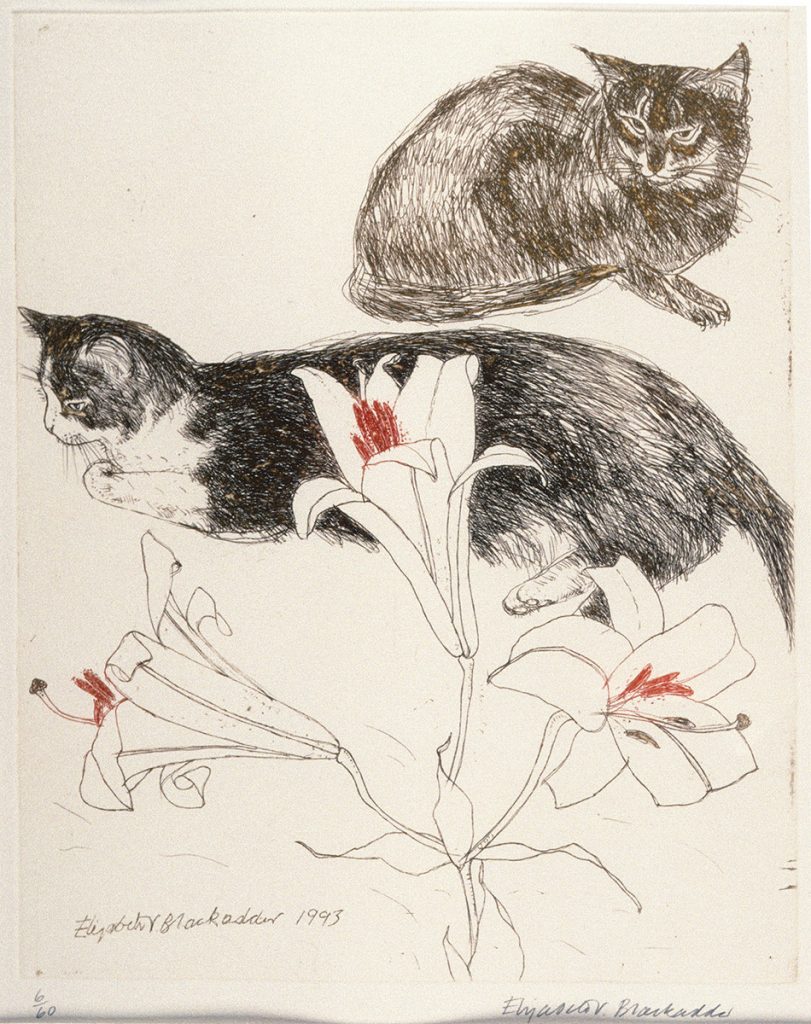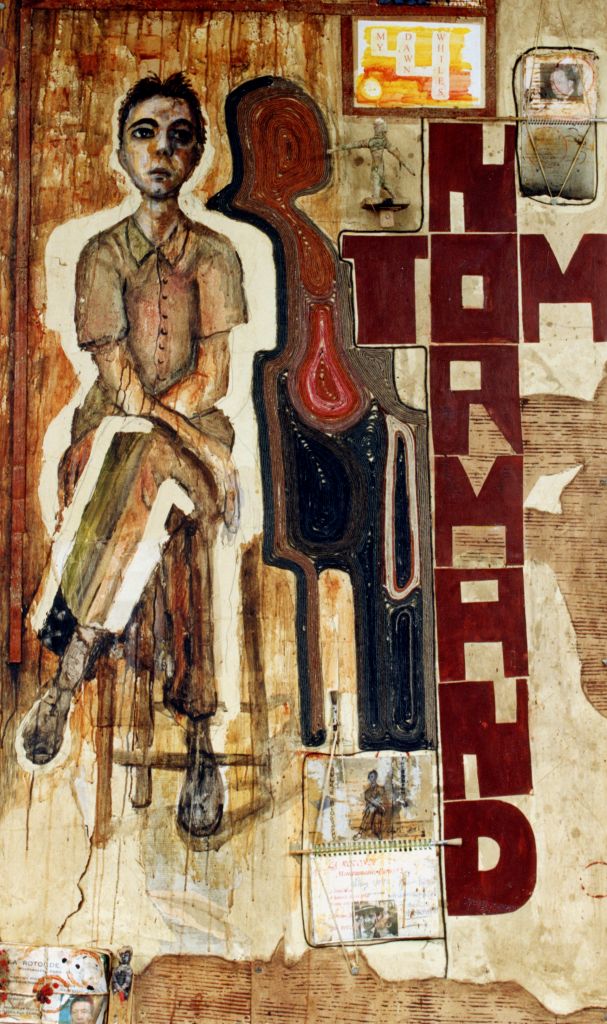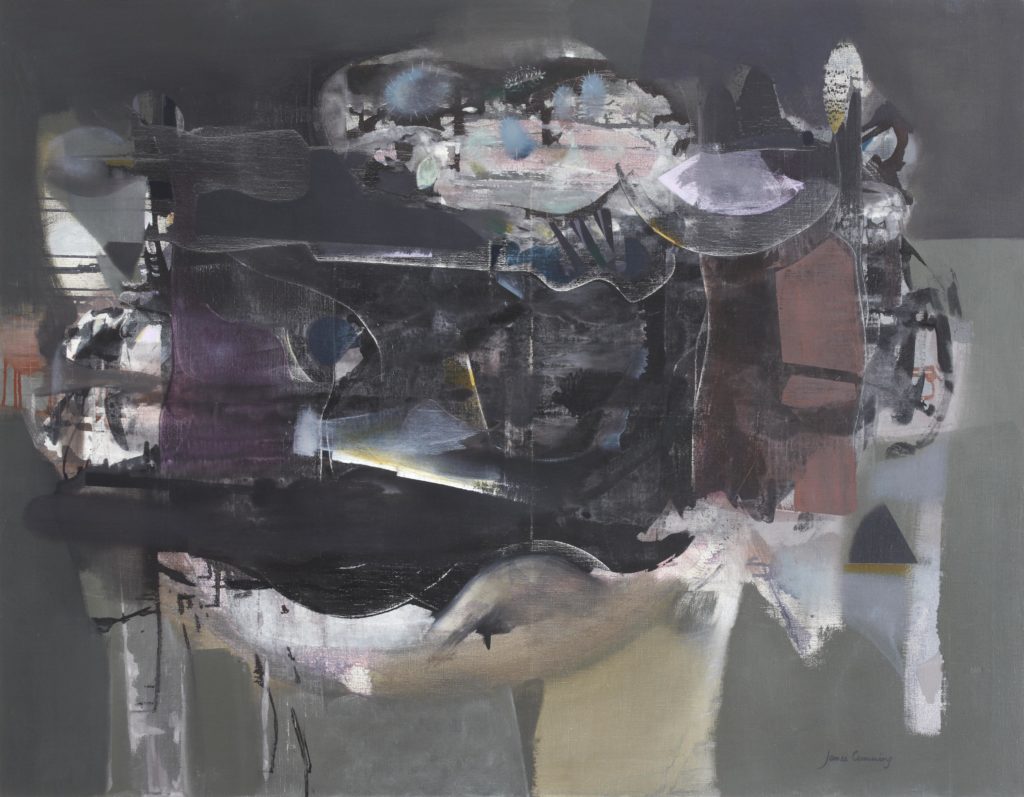
image courtesy of the University of St Andrews
This year marks the 25th anniversary of the launch of the Harry and Margery Boswell Collection of Scottish contemporary art held in the Art collections of the University of St Andrews. A series of interviews with some of the people involved in assembling the collection and artists themselves provides a deeper insight into what it means to those who have created the works to have them held in this wonderful collection. Clare Fisher, PhD student at the University interviewed Dr Tom Normand Honorary Research Fellow in the School of Art History and co-ordinator of the collection on what the Boswell Collection means to him.
How did you become involved in the Boswell Collection, what was your role?
This was a generous gift from the Boswell family, and it came as a pleasant surprise for all of us involved.
In fact, it wasn’t presented to the School of Art History but was directed towards the St Andrews Scottish Studies Institute. SASSI was an interdisciplinary group that offered a degree in Scottish Studies. These degrees encompassed aspects of Scottish Literature, Modern and Medieval Scottish History and Art History, all focussing on aspects of Scotland’s contribution to world culture. I was the art historian in the group. Douglas Dunn, the eminent poet and now Emeritus Professor of English, was the Director of the Institute and suggested that the gift be used to purchase Scottish art. It fell to me to become the coordinator for the collection and its development.
Broadly, I was encouraged to conceive of the shape and nature of the collection, to source artworks, to suggest possible acquisitions and to enact the decisions of the Boswell Committee. Little did I know then that this would engage nearly twenty-three years of my life, but it was always a positive experience.

Did you know Harry and Margery Boswell? If so, can you tell us anything about their vision for the collection and its place at the University?
Sadly, Harry had passed on by the time the collection was created. I did meet Margery early in the process, but she too left us. In my opinion the collection is their memorial, I hope a worthy memorial.
For the most part I was involved with Bruce Boswell, and his siblings in the extended Boswell family. It became clear in our early discussions that they were a generous and empathic group. Also, the whole family was fiercely proud of their Scottish roots and gave expression to this in many forms, not least in their gifts to the university.
Bruce reminded us that Harry, in particular, was an avid collector of Scottish art. He frequented the auction houses in Edinburgh and Glasgow during the 1960s and had acquired a fine collection of historical and contemporary works. The collection at the university would recognise and expand this enthusiasm.
Of course, I was familiar with the art collections at the Talbot Rice Gallery in the University of Edinburgh and the Hunterian Gallery at the University of Glasgow. These are venerated and historic collections. In comparison St Andrews held a rather random assembly of art works, most usually casually bequeathed to the university and often arriving in our collections by accident. I had no thoughts that we could compete with the established collections in Edinburgh and Glasgow, especially given their proportion of canonical works. But the continuing generosity of the Boswell family has created the foundations of a substantial collection.

Medium: etching on paper
Size: 80cm x 64.5cm (framed)
Accession no.: HC1995.3(2)
Part of the ‘Thursdays Child’ group of prints.
© Elizabeth Blackadder
Some of the first works purchased by the Fund are part of the Thursday Child series. Could you provide any information about them and how they came to be part of the Collection (or nearly didn’t!)?
‘Thursday’s Child’ was a portfolio of prints that was available, in a limited edition, from the Dundee Printmakers Workshop. It was the first purchase for the collection. I was keen to purchase this portfolio for it included many images from The Edinburgh School, that group who were highly represented in Harry Boswell’s private collection. And so, prints by Elizabeth Blackadder and John Houston were important in this context. These were complemented by the works of younger artists including Margaret Hunter, June Redfern, Elspeth Lamb, Elaine Schemilt and Paul Furneaux. It was a way of initiating the collection with a group of images that would give a broad representation of contemporary Scottish art, and might be displayed collectively.
Now, in those days, the physical collection of works from artists, their representatives, and dealers was nearly always my responsibility; I travelled over half of the country visiting studios and galleries to accept the works and to return them to St Andrews, by car. In this process, ‘Thursday’s Child’, the first item in the collection, was lost. I say lost, but I had placed the portfolio on the roof of my car, turned and spoken to someone, then drove way with the portfolio still on the roof. Not my finest hour.
When I realised what I’d done I was distraught. I did that classic thing. I went to the local police station and asked if anyone had handed in a red box with the words ‘Thursday’s Child’ embossed on the lid. Amazingly, a laughing officer reached under the counter and handed me the box. It was flattened and with a tyre track beautifully impressed across the embossed lettering. Those familiar with Robert Rauschenberg’s 1953 work titled Automobile Tire Print will understand. Anyhow, I went back to the Dundee Printmakers Workshop and showed them the evidence of my hapless incompetence. To their eternal credit they simply gave me a replacement portfolio. But true, this was not my finest hour.

Medium: mixed media on canvas
Size: 182cm x 97cm
Accession no.: HC1999.1
©The Estate of Steven Campbell, Courtesy of Marlborough Fine Art
Your involvement has been central to the success and growth of the Collection, but you are also integral to it in other ways. Can you tell us about Steven Campbell’s portrait of you? How did that come about, what’s the story behind it?
Well, this was neither planned, nor desired on my part. I didn’t know Steven Campbell, but I knew he should be approached for the collection. He had a stellar career, in New York city, during the 1980s and was lionised on his return to Scotland late in that decade. I approached him, by letter, with a modest budget and suggested we would like a print for the Boswell Collection. He was fine with this, but shortly after he called me and said he wanted to paint my portrait. I was temperamentally reluctant to agree this but Steven was a very forceful character. He visited me at home and took away some photographs. It happens that the one he used in the portrait was an early 1980s photo of me, taken by Calum Colvin, in Duncan of Jordanstone College of Art. So, the young man in the painting is a tyro teacher in the art college; looking wide-eyed and terrified.
The constructed artwork is a typically visionary and vivid work by Campbell: by turns comic and ironic, inventive and challenging, benign and acerbic. I recall that he would telephone me, at odd hours, asking questions about my work and opinions. He also said that he wanted the image to resemble a poster, left to deteriorate in a Parisian café, and so embodying a passage and a history. In this way the work incorporates a stylised version of the Colvin photograph with a negative shadow behind this representing my image in the present time of the portrait. Also, a number of sketch books and other objects are pressed into the picture. The sketch books are quite detailed and show his workings and thoughts. There is a host of other esoteric symbols and insignia, and, of course, my name emblazoned on the image.
After some negotiation we bought it into the collection. I must admit it is a bit of a burden for it will be difficult to conserve. Still, it’s one of the very few portraits that Steven Campbell ever undertook during his lifetime.
The focus of the Collection is Scottish art. How did you think about ‘Scottishness’ when selecting works for it? What is distinctive about Scottish art?
Of course a question like this is fraught with political and cultural issues, particularly in the current climate. For me Scottish art was, and is, simply art from Scotland; in the broadest sense.
It is the case that as I emerged as an academic certain national discourses were prevalent within the discipline. So much so that the Royal Academy, in London, ran blockbuster exhibitions on the subject of ‘German Art in the 20th Century, ‘Italian Art in the 20th Century’, and ‘British Art in the 20th Century’: indeed ‘The Vigorous Imagination’ exhibition was a riposte to this last presentation which had barely represented Scottish art in the context of Britishness. In some senses, then, the collection was designed to foreground artists whose work was marginalised or under-represented in the wider context.
But, it was never the case that artists were obliged to be Scots, or to live and work in Scotland. They should only, in their biography, training, or output have some meaningful connection to Scotland.
Given this open and fluid sense of Scottish art it is near impossible to give a ‘definition’ of the field. Indeed, I would be chary of this kind of essentialism. It is the case that many of the works I was engaged in collecting had connections to Scottish history, cultural mores, and national characteristics, but this was often secondary to their being simply fine works of art by eminent artists.
Moreover, I’m deeply sensitive to the way that the discipline of art history has developed in the contemporary period. The kind of ‘national discourses’ I have spoken of are now suspect in the academies. Issues of globalisation, and more importantly the debates surrounding the decolonisation of the curriculum have impacted upon these types of approaches. The challenge in the future will be to collect Scottish art that is attuned to these changing tropes.
What or who inspired your own interest in Scottish art? How have you applied that expertise to the Collection, as well as any insights gained from knowing some of the artists personally?
Again, this is historical; and suddenly I feel old.
I came to the discipline from a background in sociology. My interest was in art, social class and ideology. This was part of something then called the ‘New Art History’, the development of an interdisciplinary approach that eschewed traditional methodologies and looked to view art within the frame of critical theory, politics, feminism, psychology and related fields of study.
In this respect, I had focussed on British art. Principally because I had no expertise in languages, but also because I was interested in the ways that modern(ist) British artists varied in respect of the political debates of the 1930s. Consequently, I wrote my doctoral thesis on the ways in which Wyndham Lewis’s ‘fascism’ was embedded in his art.
Later this developed into a concern with Scottish art. Partly because I recognised that Scottish art was ‘lost’ within the discipline.
In fact, this became most evident in the period after the failed Devolution Referendum of 1979. Following this there emerged a desire to foreground Scotland’s distinctiveness in all kinds of areas. In art history Duncan Macmillan would publish his ‘Scottish Art 1460-1990’ and this was the first comprehensive survey of Scottish art since James Caw’s ‘Scottish Painting Past and Present 1620-1908’, published in 1908. There flowed from this not so much a torrent but at least a bubbling burn of books, articles and catalogue essays on Scottish art; I contributed to this stream and it became my specialism.
It was in this context that I tried to provide for the Boswell collection the best and most dynamic artists from Scotland in the period. Naturally, I was assisted in this by the fact that I was writing on their work, and presenting essays in their catalogues. It was a natural synergy made easier by the fact that Scotland is a small nation, and is generally collaborative in matters of culture.

James Cumming
Medium: Oil on canvas
Size: 111.3 x 141.5 cm
Accession no.: HC2016.24
© The artist’s estate
Do you have a favourite work in the Boswell Collection?
This is interesting. As I look at the collection online I see Anne Redpath’s Still Life, Abstract from 1962. Increasingly I’ve admired Redpath’s work and this is a fine example. In fact the last piece I wrote, before retiring from the university, was an essay on Redpath published in the book I edited on the collection in the Royal Scottish Academy; the book was Ages of Wonder: Scotland’s Art 1540-now. The irony is I think this work entered the collection after my tenure for during my time the work of Redpath was prohibitively expensive. Whatever, this is a fine painting.
Of course, it’s impossible to have a favourite work but let me suggest James Cumming’s Croft Table with Field Flowers and Wine Jars, 1962. When I demitted from the committee, after some twenty-two years, the Boswell’s kindly offered a sum of money to purchase a kind of ‘memorial’ piece that would recognise my service and would become part of the collection.
Cumming is a fascinating artist, and hailed from my home town of Dunfermline. An collegial figure in The Edinburgh School he was also an academician. But his style was modernist and an intriguing take on post-cubist experiment.
Anyhow, when he completed his training at Edinburgh School of Art he was awarded a travelling scholarship. Invariably Scottish artists went to France, or Italy, sometimes to Spain. Cumming chose to go and live with crofters on the Isle of Lewis, in the Outer Hebrides. This dark, sensual painting is a memory of those ‘Black Houses’ and the lives of their inhabitants. It is both local and particular in its subject, while being modern and expansive in its style and vision. Perhaps this combination is what I always aimed for in collecting Scottish art for the Boswell Collection.
Clare Fisher is a PhD student in the School of Art History funded by the Scottish Graduate School for the Arts and Humanities. Her research explores the discourse of monumentality in the United States from the Civil War to the present day.